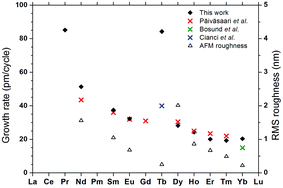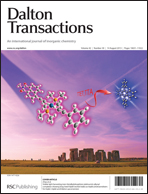Ln2O3 thin films with optically active f-electrons (Ln = Pr, Nd, Sm, Eu, Tb, Dy, Ho, Er, Tm, Yb) have been grown on Si(100) and soda lime glass substrates by atomic layer deposition (ALD) using Ln(thd)3 (Hthd = 2,2,6,6-tetramethyl-3,5-heptanedione) and ozone as precursors. The temperature range for depositions was 200–400 °C. Growth rates were measured by spectroscopic ellipsometry and a region with a constant growth rate (ALD window) was found for Ln = Ho and Tm. All the compounds are grown as amorphous films at low temperatures, whereas crystalline films (cubic C-Ln2O3) are obtained above a certain temperature ranging from 300 to 250 °C for Nd2O3 to Yb2O3, respectively. AFM studies show that the films were smooth (rms < 1 nm) except for depositions at the highest temperatures. The refractive index was measured by spectroscopic ellipsometry and was found to depend on the deposition temperature. Optical absorption measurements show that the absorption from the f–f transitions depends strongly on the crystallinity of the material. The clear correlation between the degree of crystallinity, optical absorptions and refractive indices is discussed.


 Please wait while we load your content...
Please wait while we load your content...